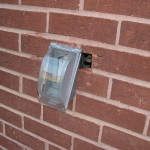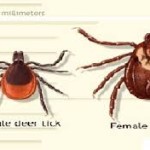Forming a battlefront against pests in schools: the pest management team
By Rosemary Hallberg, Southern IPM Center and Janet Hurley, TX A&M AgriLife Extension
Think of a school IPM program as a battle with a powerful army. The more people you have on your side, the more likely you are to have victory. Insects and small rodents may be smaller than us, but they adapt quickly and enter and exit through places that are normally ignored by people, such as tiny cracks under a door or a small hole in a dark corner. To outsmart insect and mammalian pests, people have to do two things: think like a pest and work as a team.
 Think like a pest? That sounds crazy, right? Fortunately, scientists at Texas A&M AgriLife Extension have a tool that helps even the person who is totally unfamiliar with insect habits to find places where insects may be gaining access to or residing in a building. Known as the IPM Risk Calculator (http://ipmcalculator.com), this 92-item questionnaire leads the IPM Coordinator on a virtual scavenger hunt around crevices and into floor drains and pipes—inspecting every nook and cranny that may be hospitable to an insect.
Think like a pest? That sounds crazy, right? Fortunately, scientists at Texas A&M AgriLife Extension have a tool that helps even the person who is totally unfamiliar with insect habits to find places where insects may be gaining access to or residing in a building. Known as the IPM Risk Calculator (http://ipmcalculator.com), this 92-item questionnaire leads the IPM Coordinator on a virtual scavenger hunt around crevices and into floor drains and pipes—inspecting every nook and cranny that may be hospitable to an insect.
The benefit to the Risk Calculator is that it will not only alert the facilities staff to the potential, or risk, of various pests in the building, but it will also reveal places that might already be popular to pests, such as under a leaky pipe or in a cluttered storage closet.
The IPM Coordinator in a school is the main contact for the environmental quality team for the school or district. That person not only should have some education (or be able to attain it) in integrated pest management, but he or she must work with upper administration, principals, teachers, custodians, food service, maintenance, and sometimes the students to make sure everyone hears the same message, and is on the same team.
The Team
The school IPM team should consist of the following players, each contributing to the overall goal of the school to keep students safe from pests and an abundance of pesticides:
School Administrators: Administrators should review the state laws about IPM in schools, pesticide use in school, any other regulations addressing pest management and the district’s IPM policy. Not every state has laws governing pest management in schools, and many of the ones that do have unfunded mandates. However, even without a law, the major role of the school administrator should be to keep students safe and support the IPM Coordinator’s efforts to do the same through IPM methods that may not involve daily or weekly pesticide sprays.
Administrator responsibilities include:
- Adopting and maintaining an IPM policy.
- Including IPM and part of the health and safety committee, if applicable.
- Designating and supporting training for an IPM Coordinator.
- Support policies recommended by the IPM Coordinator.
- Encourage teachers and staff to respect guidelines of the IPM program.
School Nurses: The nurse should be familiar with the IPM policy and plan and aware of when pesticides are scheduled to be applied on the property. He or she should also be familiar with symptoms of pesticide poisoning and signs of pest infestation from head lice, fire ants, bed bugs, and ticks. In addition, he or she should know:
- The probability of exposure to rabies, mosquito-borne diseases, tick-borne diseases and of asthma.
- The names of students with asthma, chemical sensitivities and allergies to stinging insects.
- Information on IPM strategies for pests that can affect student health.
- How to contact the IPM Coordinator when there is a pest issue affecting the health of a student.
Teachers, Staff and Students: Since many pest outbreaks occur in the classroom,  teachers need to understand how to report pest sightings, be familiar with pest identification and understand the importance of keeping the classroom clean. Teachers should educate their students about how they can help keep the classroom uninviting to pests and should know the proper method to contact the IPM Coordinator and report pests in the classrooms. Athletic staff should routinely walk the fields to inspect for ant mounds or bee and wasp hives.
teachers need to understand how to report pest sightings, be familiar with pest identification and understand the importance of keeping the classroom clean. Teachers should educate their students about how they can help keep the classroom uninviting to pests and should know the proper method to contact the IPM Coordinator and report pests in the classrooms. Athletic staff should routinely walk the fields to inspect for ant mounds or bee and wasp hives.
Keeping a clean classroom means:
- No food leftover after students leave the building, including in teachers’ desks.
- Organize files and supplies to reduce shelter for cockroaches and mice.
- Be sure locker rooms are clean and food-free.
Parents: While parents may not be on school property, they are a valuable part of the team as well. Parent support for the IPM policies can strengthen the school’s or district’s IPM program. In addition to providing the school nurse with a list of the child’s allergies and sensitivities (e.g. to stings), the parent should:
- Talk to the child about pest issues and pay attention to notices involving when the school will be chemically treated.
- Notify the school nurse and the administration of a child who is sensitive to chemicals.
- Bring the benefits of IPM home by practicing IPM at home and involving the child in actions such as identifying and reporting pests.
Keeping the enemy away:
Long ago in much of Europe, warriors used to protect their people from enemies with a formidable castle, often surrounded by a large moat. Obviously schools aren’t as intimidating as castles, at least not to a pest! However, the school team can adopt two strategies that will help discourage unwanted insects and rodents from entering. They’re called “sanitation” and “exclusion.”
Sanitation: Sanitation involves any action that cleans or neatens an area. While this may sound like routine cleaning, having a clean, orderly workspace will keep more pests out of a space than a pesticide application.
- Food products should be stored on industrial grade, stainless steel wire shelving, at least 6 inches from walls and 12 inches from the floor.
- Food should be stored in resealable containers that remain sealed while food is not used.
- Food prep areas should be cleaned and disinfected once a day, including mopping and cleaning of floor drains.
- If the classroom is used for meals, food waste should be disposed of in a single container and removed from the room at the end of the day. Any spillage should be reported to the custodial staff as soon as possible.
- Classroom supplies should be stored neatly in plastic, not cardboard, containers.
Exclusion: Exclusion is a vital part of IPM as it serves to prevent pest problems before they happen. Exclusion involves preventing entry to the building in the first place.
- Cracks and crevices around windows, doors, bathroom fixtures, moldings, water fountains, utility lines, bulletin boards and blackboards should be sealed with caulking material.
- Any openings or gaps larger than ¼ inch should be sealed or narrowed. Under doors, for instance, install a door sweep.
- Holes around pipes and soffits, and cracks in walls and foundations should be sealed with a durable sealant.
- Exterior doors should remain closed at all times except for exit or entry.
- Garbage cans and dumpsters should sit at least 10 to 50 feet from the entryways. Rodents love garbage and can slide through an open door while the kitchen staff is disposing of trash after lunch.
- Shrubs and trees should be trimmed at least 1 foot away from exterior walls and rooflines.
- Exterior lighting should consist of low-pressure sodium vapor lights rather than halogen bulbs. Replacing the bulbs discourages crickets and spiders.
- All metal overhangs and roof edges should be sealed to avoid nesting of flying insects, bats and birds.
For any battlefront to be successful, everyone needs to be on the same team. As everyone in the school works together to keep pests out and pesticides at a minimum, they also make the school building more energy efficient (because of sealing cracks) and safer (by keeping exterior doors closed and reducing the need for pesticide applications. That is definitely a goal that every member of the team can live with.
Resources:
http://www.extension.org/urban_integrated_pest_management
School IPM 2015 Pest Management Strategic Plan
Check out US EPA’s newly renovated Healthy Schools Website!
To better serve our schools community, the US EPA has made a few changes to its www.epa.gov/schools website. The schools website is an excellent resource to find all you need to know about beginning, maintaining or enhancing healthy school environments for children. We’ve added new information and reformatted the site to provide for a more user friendly experience. You will find the latest school environmental health news on our “School Bulletin” board, as well as resources and tools to create or enhance healthy, safe learning environments for children.
Kara Belle
US EPA
Office of Children’s Health Protection
Dealing with Ticks on School Properties? (While written for the northeast this is good info for all)
By Kathleen Murray, Ph.D., Coordinator, Maine School IPM Program, Maine Department of Agriculture, Conservation and Forestry
Start by Identifying and Assessing the Pest. Gordon Murray, IPM Coordinator at Maine Regional School Unit 2 has successfully used a ‘tick drag’ to monitor for ticks at Hall-Dale Elementary School. In 2012, a large number of dog ticks were found on outbuildings surrounded by tall grass behind the school. Using the tick drag he found no ticks on the playgrounds or lawns, but large numbers of the American dog tick in the tall un-mown grass near forested edges of the property. Because dog ticks do not carry Lyme disease and his monitoring efforts showed the ticks were not present in the mowed lawns and playgrounds, the school took an educational approach – working with school staff to keep kids out of the un-mown edge areas and informing families about the importance of tick checks at home. In May 2014, the school nurse reported dog ticks found on students, so Gordon dragged the grass and playgrounds again. This time he didn’t find any ticks. What to do? Gordon plans to let the principals, teachers and nurses know the RSU 2 IPM program is monitoring for ticks and following tick-safe property management protocols (see below). He’s also working with school administrators and nurses to distribute educational materials to families emphasizing personal protective actions: using repellents on clothing and exposed skin when in tick-infested areas off school grounds, as well as showering, changing clothes, and checking family members for ticks after coming indoors at home. He may mark off un-mown areas at the edges of the school yard to help keep kids out of potential tick habitat, too. For now, these measures appear to be enough to effectively minimize tick threats on school properties and help families prevent tick encounters at home.
Know Your Ticks
- Deer Tick: carries Lyme disease, anaplasmosis, babesiosis. Dark reddish color. Nymphs: pin-head sized. Adults: sesame seed-sized. Found in and at the immediate edge of hardwood forests.
- American Dog Tick: potential carrier of Rocky Mountain Spotted Fever but, to date, no Maine-acquired human cases have been reported. 3/16” to ½” long. Brown with silver markings. Found in unmown grassy and scrubby fields.
Tick-Safe School Property Management Protocols
- Keep grass mowed.
- Reduce cover for mice. Eliminate wooded, brush-covered habitat, prune lower branches of bushes, clean-up storage areas, woodpiles and junk piles. Remove vegetation and debris around stone walls.
- Remove leaf litter, brush, and weeds at the edge of the lawn.
- Keep playground equipment away from woodland edges and place them on wood-chip or mulch-type foundation.
- Use wood chips under shade trees to reduce tick abundance. Avoid groundcover plants such as pachysandra in areas frequented by people.
- Trim trees and brush to open up wooded areas in and around areas of human activity, allowing sunlight to penetrate to reduce moisture and thus reduce tick habitat.
- Move bird feeders away from school buildings.
- Reduce deer habitat or erect deer-exclusion fencing.
- Avoid landscape plantings that attract deer or use deer-exclusion fencing to keep deer off school properties.
- Create three foot or wider wood chip, mulch, or gravel border between turf and woods.
- Widen woodland trails/walkways to permit trail-users to avoid contact with woody vegetation and tall grasses.
Personal Protection
- Avoid tick-infested areas, especially in May, June and July.
- When going outdoors, apply a tick-effective repellent to clothes and exposed skin. Repellents containing 20% DEET are effective. The EPA Repellent Selection Tool is an excellent resource for information about repellent products and their use. Wash repellents off skin after returning indoors.
- Clothing can be treated with permethrin, which kills ticks on contact. Only use products labeled specifically for treatment of clothing.
- Shower as soon as possible after being outdoors.
- Check yourself and family members for ticks after returning from potentially tick-infested areas, including your backyard. Use a mirror. Feel and look for small brown bumps on scalp, in and around ears, under arms, in belly button, around waist, between legs, and the backs of knees. See www.cdc.gov/features/stopticks/
- Attached ticks should be removed with tweezers or tick removal device by grasping the tick close to the skin and gently pulling until it releases.
Application of Pesticides
Schools concerned with frequent deer tick encounters on school properties may wish to consult with a licensed commercial pesticide applicator. A single spray (directed into and immediately at the edge of wooded areas in mid-May to early June) of pesticide product labelled for wide-area tick control, applied with sufficient volume and pressure to penetrate vegetation and leaf litter, has been shown to be effective in controlling ticks through the summer season. A second application in the fall to kill adult ticks will help reduce tick populations the following year. Spraying open fields and lawns is not necessary.
FMI:
- Maine School IPM Tick Fact Sheet
- GotPests.org (type tick) into the search bar
- Maine Center for Disease Control and Prevention
- eXtension School IPM Action Plan for Ticks
- TickEncounter.org (Univ. of Rhode Island)
- University of Maine Tick Identification Lab
- Texas and Southern US



 .
.